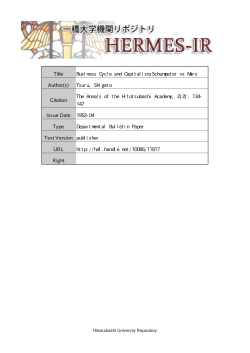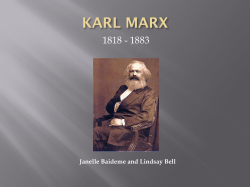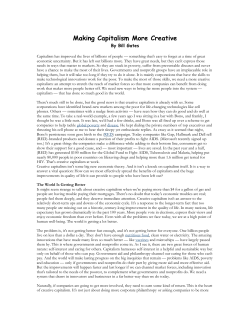
Economics for Democratic Socialism Drexel University Spring Quarter 2009
Economics for Democratic Socialism Drexel University Spring Quarter 2009 Synthesis • Again recall P=A+F=E+B+D+U+V-W • Suppose U+V-W=0 and U/P is about constant. • We have A+F=E+B+D=K+D Employment 1 • • To approximate employment, use the multiplier concept. i. ND Actually, the multiplier for deficit spending will depend on the proportion of tax cuts and infrastructure projects. ii. NG with D=G-T, government spending minus tax receipts. But we will ignore that complication. Employment 2 • Let N0 be the employment target • We can turn equation ii around: D Adjusting D to obtain the target employment is called “fiscal policy.” Classical View • The classical view is that such government policy will never be necessary (except, perhaps, on a temporary basis). • Adjustment of the interest rate and the real (purchasing power) wage will bring the demand for labor into equality with the supply. • Lewis’ socialist view (and his ideas generally) are quite classical in this sense. • Unfortunately, the facts do not seem to agree. Employment 3 • To maintain target employment we have two conventional methods. 1. 2. Monetary policy “stimulates” the economy by lowering interest rates may be limited by a “liquidity trap” Certainly interest cannot go below zero Fiscal policy “stimulates” by government purchases of goods and services or by tax cuts Employment 4 • • • Suppose that, year after year, Then D must grow year after year. To maintain A+F=E+B+D, A or F or both must continue to increase every year. This may be inconsistent. What if people don’t want to hold increased assets -- that is, they want to spend them instead? Higher interest rates might persuade them -otherwise, inflation may result. Iceland 1 • Consider, for example, Iceland. – In Nov. 2007, unemployment was less than 1%, inflation was a problem. – Icelandic banks were making loads of money borrowing and lending abroad. – They also had a housing bubble. – The Crown (Icelandic currency) was depreciating. – They raised the interest rate to 13.75 to restrain inflation and slow the depreciation. Iceland 2 • “The nation's celebrated rags-to-riches story began in the Nineties when free market reforms, fish quota cash and a stock market based on stable pension funds allowed Icelandic entrepreneurs to go out and sweep up international credit.” • “But, as a result of the international banking crisis, the billionaires who own everything from West Ham United football club to the Somerfield supermarket chain, Hamleys toy shops and the House of Fraser, are in trouble and the country is drowning in debt.” – -- Huffington Post, Oct 6. 2008. Iceland 3 • Their banking system collapsed in October, 2008. Three of four banks in the country were nationalized. • But no-one would buy Icelandic bonds. • They sought aid from the IMF. • Interest rates went up to 18% in October, and would have been higher had they not gotten an IMF loan. • They are now 17%. • Unemployment more than tripled as production declined by about 10% (projected). Exception? • Yes. Iceland is a small country, and its experience has been extreme. But there has been concern that Britain and Italy could experience similar collapses of demand for their government bonds, and while the United States is not close to that situation -– “It can’t happen here” are dangerous words! Socialist Alternative 1 • Suppose instead that there is a social production sector. Its only asset is its productive capital R. It has no liabilities. Investment in expansion of the social production sector comes from reinvestment of earnings and/or tax receipts. • The formula for employment becomes ND+R with D=G-T+R-nR, where, again, G is government purchases, T taxes, and nR the net income of the social production sector available for re-investment. Socialist Alternative 2 • Instead of expanding the government deficit in a crisis, the socialist system could expand the sector of socialist production, “stimulating” the economy by increasing R. • According to Keynes, K (investment) is largely determined by business expectations, which cannot be rational, but can be modified by experience. • Success in “stimulating” the economy could prove to be the kind of experience that would lead to business optimism and increases in K. • Then R would be cut back, and instead government could expand socialism by buying corporate shares, as Lewis suggested. Conclusion • Keynesian economics is our best guide to the consequences of an economic crisis and the government policies that may ameliorate them, in the short run. • However, as conservatives warn, continued Keynesian policy may lead to further and worse crises. • A mixed socialist system would have at least one more “degree of freedom” to stabilize the capitalist economy. • This requires a sector of social commodity production, and its expansion decisions must be independent of the state of business expectations. Capitalism and Crisis • Marx and Schumpeter have both argued that crises or business cycles are unavoidably a part of capitalism, and that capitalism will cease to exist. – Marx argues that the crises become more serious and ultimately destroy capitalism. – Schumpeter argues that capitalism will be destroyed by its successes, not by crises -- but one process undermining capitalism is that people with higher standards of living are not willing to accept the uncertainty of capitalist development. Marx’ Economics • Marx adopts and adapts David Ricardo’s Labor Theory of Value. • On this basis he develops a theory of (accounting) profit -- that profit is exploitation. • This analysis also leads him to a theory of crises. Crises • A good deal of Capital also deals with this tendency toward crises. Indeed, Marx sees capitalism as increasingly unstable, until at last the crises destroy capitalism and the working class, itself a product of capitalism, takes over. • Could Marx have been at least half right? Capitalism as he knew it did collapse in 1929 -• But as for the part about the working class taking over …? Crises and Unemployment 1 • Marx didn’t really set out one clear theory of crises. He did argue that – With the rising organic composition of capital, profits decline; – The working class is “immiserized.” – Engels writes “… violent and regularly recurring industrial vacillations determine on the one hand the existence of a large reserve army of unemployed workers, …” Crises and Unemployment 2 – And Marx, in Capital, “… subordination of labour to capital continues in many branches of production, and continues longer than seems at first glance compatible with the general stage of development. This is due to the cheapness and abundance of disposable or unemployed wage-labourers, …” – Critics argue, with mathematical models, that it is not possible both for profit rates to fall and for the working class to be worse off. But the mathematical models do not allow for unemployment (or bankruptcy). Labor Theory of Value 1 “The value of a commodity, or the quantity of any other commodity for which it will exchange, depends on the relative quantity of labour which is necessary for its production, and not on the greater or less compensation which is paid for that labour. “If I found that an ounce of gold would exchange for … less …, I should be justified in saying that the cause … was … the smaller quantity of labour necessary to obtain it.” Labor Theory of Value 2 “ …in estimating the exchangeable value of stockings, for example, ... First, there is the labour necessary to cultivate the land on which the raw cotton is grown; secondly, the labour of conveying the cotton to the country where the stockings are to be manufactured, … thirdly, the labour of the spinner and weaver; fourthly, a portion of the labour of the engineer, smith, and carpenter, who erected the buildings and machinery, by the help of which they are made; …” From Capital (1) • “Cooperation ever constitutes the fundamental form of the capitalist mode of production …. • “The work of directing, superintending, and adjusting, becomes one of the functions of capital, from the moment that the labour under the control of capital becomes cooperative. • “[T]he product is the property of the capitalist and not that of the labourer, its immediate producer. Suppose that a capitalist pays for a day's labour-power at its value; then the right to use that power for a day belongs to him, just as much as the right to use any other commodity, such as a horse that he has hired for the day.” From Capital (2) • “[We assume] ... that the value of a day's labour-power is three shillings, and that six hours' labour is incorporated in that sum; and consequently that this amount of labour is requisite to produce the necessaries of life daily required on an average by the labourer. • “If now our spinner by working for one hour, can convert 1 2/3 lbs. of cotton into 1 2/3 lbs. of yarn, • “The labourer therefore finds, in the workshop, the means of production necessary for working, not only during six, but during twelve hours. • “20 lbs. of cotton will absorb 12 hours' labour and be changed into 20 lbs. of yarn. From Capital (3) • ‘There is now materialised in this 20 lbs. of yarn the labour of five days, of which four days are due to the cotton and the lost steel of the spindle, the remaining day having been absorbed by the cotton during the spinning process. Expressed in gold, the labour of five days is thirty shillings. • ‘But the sum of the values of the commodities that entered into the process amounts to 27 shillings. … surplus-value of 3 shillings has been created. • ‘…the capitalist as buyer paid for each commodity, for the cotton, the spindle and the labour-power, its full value. He then did what is done by every purchaser of commodities; he consumed their use-value. From Capital (4) • “… the labour-process may continue beyond the time necessary to reproduce and incorporate in the product a mere equivalent for the value of the labour-power. Instead of the six hours that are sufficient for the latter purpose, the process may continue for twelve hours. The action of labour-power, therefore, not only reproduces its own value, but produces value over and above it. This surplus-value is the difference between the value of the product and the value of the elements consumed in the formation of that product, in other words, of the means of production and the labour-power.” From Capital (5) • “The capital C is made up of … the sum of money c laid out upon the means of production, and … the sum of money v expended upon the labourpower;… At first then, C = c + v: for example…. When the process of production is finished, we get a commodity whose value = (c + v) + s, where s is the surplus-value; … The original capital has now changed from C to C', from £500 to £590. The difference is s or a surplus value of £90,…” The Composition of Capital • c is the money value of raw materials (and of machinery used up), the “constant capital.” • v is the wage bill, the “variable capital” • C=c+v is the “capital” laid out to begin production • v/c is the “composition of capital.” • In Capital, v. 1, Marx makes the simplifying assumption that the composition of capital is the same in every industry. • In v. 3 he reconsiders that assumption. Profit 1 • The value of the day’s product is more than c+v, and the difference is s, the surplus value. The value is c+v+s • For Marx in volume 1, the rate of profit is s/(c+v) • This reflects the simplifying assumption that constant capital (machinery et. al.) is used up during the “period of production.” In later volumes Marx corrects for that. • The simple version will do for our purposes. Some Problems 1 • In volume 3, Marx discovered a problem with this approach. Indeed it was a problem with all classical economics. • The rate of profit, s/(c+v) would depend on the organic composition of capital, v/c, and that composition would differ from industry to industry. • However, all classical economists (including Marx) postulated the equalization of rates of profit as a result of competition. • This postulate now seems to conflict with the labor theory of value. Some Problems 2 • Marx suggested that the rate of profit would depend on the surplus value and composition of capital in the economy as a whole. • There were mathematical complexities in this that were not resolved until the 20th century. • Another problem is: what do we mean by the labor cost of labor? • For a Marxist approach, it is NOT subsistence. • A Japanese Marxist, Okishio, proposed a common solution to both problems in 1961. Modern Labor Theory 1 • Actual prices (values) proportional to embodied labor time plus a profit mark-up. • The cost of labor depends on the conventional standard of living of the working class. • It is the labor cost of producing the goods and services that comprise that conventional standard of living • It is, in other words, a “cost of living” index in labor value terms. Modern Labor Theory 2 • The mark-up depends on surplus value and invested capital in the economy as a whole. • For the individual capitalist, however, profit will still depend on surplus value and the composition of capital in his operation. Decreasing Rate of Profit 1 • According to Marx, the rate of profit tends to decrease. • In the search for higher profits, businessmen introduce new techniques with more constant capital, that is, machinery. • Therefore, the organic composition of capital, v/c, rises. • In the profit rate, s/(c+v), the denominator rises. • Initially, for an individual firm, s rises more, increasing profit. Decreasing Rate of Profit 2 • However, other capitalists imitate the innovation, reducing the value (socially necessary labor time) of the commodity. • (This is closely related to Schumpeter’s idea that profits arise only transitorily, as a result of innovation, and to the neoclassical idea that the normal rate of “economic profit” is zero.) • As firms throughout the economy increase their c, the overall c in the entire economy rises, without overall increase in the surplus (since labor values decline), so that the normal profit rate -- the mark-up -- tends downward. Profits and Crises • For Marx, the declining rate of profit is a key factor leading to crises. • In their attempts to keep the profit rate up, businessmen adopt more and more risky and complicated business plans. • Inevitably, some of these fail, and dominoes begin to fall. • Since production is more and more “socialized” -- largescale, capital-intensive and interdependent -- the fallingdominoes results are more and more far-reaching. Immiserization • Marx argues that as the profits fall, the working class is “immiserized” -- made more miserable. • Simply -- to try to keep profits up, capitalists would find ways to push the conventional standard of living of the working class down. • Some modern economists have argued that this is mathematically impossible -- that falling profits must be associated with rising wages. • However, this overlooks unemployment, the “industrial reserve army.” Standard of Living • In fact, labor standards of living have risen in the twentieth century, in more developed countries. • But not always. • In the last third of the 20th century, in the USA, median wage income did not rise significantly. Labor Theory and Unemployment • Recall the Keynesian “45°” model of unemployment. I am going to translate it into labor theory terms. Fair warning: this has not been published and so cannot be regarded as a scholarly discussion. Labor Value Expenditures • Let Y be the labor cost of a unit of labor, i.e. of the goods and services that make up the conventional standard of living. • Let N be the number employed. • Assume “workers spend what they get.” • Then working class consumption, in labor value terms, is YN. • Aggregate surplus value is N(1-Y) • Given the state of long-term expectations, the capitalist class demands new capital goods with aggregate labor value T. Labor Demanded 1 • For now, assume also that capitalists consume nothing -- they are accumulation machines! • Total labor value of goods and services demanded is T+YN. • That must also be the total labor employed, i.e. N= T+YN Labor Demanded 2 The Result of a New Technology Lump of Labor • Economists sometimes criticize others for committing the “lump of labor” fallacy. • The fallacy is that somehow there is just a “lump” of labor demand that has to be divided among available workers. • Perhaps there is, though -- the labor cost of producing a conventional standard of living of labor. • In any case: the “technological unemployment” we see here could be offset by an increase in the labor standard of living, but that is against the interest of capitalists, who will be doing their best to push it down. Crisis • For a Marxist, then, the development of capitalism tends always to bring about a falling rate of profit and rising unemployment. • Forces from outside capitalism -- such as government, war, labor unions and strikes, cultural and political upheavals -- can offset these tendencies. • This offsetting may -- or may not -- create new space for continuing capitalism. From the Manifesto, again • “The conditions of bourgeois society are too narrow to comprise the wealth created by them. And how does the bourgeoisie get over these crises? On the one hand, by enforced destruction of a mass of productive forces; on the other, by the conquest of new markets, and by the more thorough exploitation of the old ones. That is to say, by paving the way for more extensive and more destructive crises, and by diminishing the means whereby crises are prevented. • “But not only has the bourgeoisie forged the weapons that bring death to itself; it has also called into existence the men who are to wield those weapons – the modern working class – the proletarians.” Seeds of Destruction • Thus capitalism, through its drive for profits and accumulation, sows the seeds of its own destruction, according to Marx. • Schumpeter agreed, but for different reasons. • Schumpeter’s economic theory, influenced by Austrian economics, differs in important details. • He claims that capitalism will be destroyed “by its own success. Destroyed by Success 1 • Successful innovation, raising standards of living, leads to more risk aversion. – Capitalism is inherently risky. • Successful innovation leads to bigger companies, monopoly. – Capitalism without competition loses its dynamic quality. Destroyed by Success 2 • Capitalism encourages rationalization. – Bureaucracy becomes more efficient and the unpredictable nature of capitalism less tolerable. • Innovation becomes “routinized.” – Capitalist leadership is no longer needed nor useful. Destroyed by Failure • Writing in the 1970’s, John Kenneth Galbraith argued that some capitalist companies had become “too big to fail.” • He proposed that the socialism that would emerge from American Capitalism would be the “socialism of the weak” -- that some companies and industries would have to be organized by government in order to survive. • He probably DIDN’T expect that to be automobiles and Wall Street -- but -• Like Marx and Smith, he considered corporations as implicitly socialist organizations, and envisioned “socialization” as the appointment of executives and boards by government. A Variety of Points of View • Marx, we recall, was radically opposed to capitalism. • Schumpeter favored capitalism, though he preferred to leave government in the hands of the aristocracy. • Galbraith was a liberal, skeptical about capitalism but not committed to oppose it. • Keynesian analysis is helpful in understanding the impacts of crisis, but these writers help us to understand the causes of crises and their tendency to transform society. This is the way the world ends This is the way the world ends This is the way the world ends Not with a bang but a whimper. »Eliot
© Copyright 2025





















